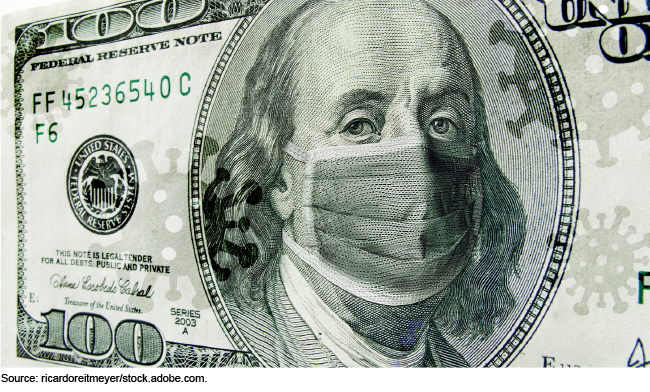Disaster Relief Fund: Lessons Learned from COVID-19 Could Improve FEMA's Estimates
Fast Facts
This Q&A report looks at FEMA's oversight of the Disaster Relief Fund, which provides federal assistance for emergencies like the COVID-19 pandemic.
As of March 2024, FEMA had committed to spend $125.3 billion from the fund for COVID-19-related assistance like vaccinations, testing sites, and more—and had spent $103.6 billion of it.
But FEMA underestimated its COVID-19-related costs. When the fund runs low, FEMA might have to delay future spending commitments. Also, FEMA hasn't identified lessons learned from the pandemic about how it estimates funding needs for catastrophic disasters.
Our recommendation addresses these issues.

Highlights
What GAO Found
The COVID-19 pandemic marked the first time the Disaster Relief Fund (DRF) has been used to respond to a nationwide public health emergency. The Federal Emergency Management Agency (FEMA), which manages the DRF, used the fund to provide pandemic assistance to individuals and 59 Tribes, states, and territories.
Although the DRF received supplemental appropriations in COVID-19 relief legislation, funding requirements for the DRF threatened to exceed available resources by August 2023. In response, FEMA implemented measures to prioritize response and immediate recovery efforts and to pause new DRF obligations that were not essential for lifesaving and life-sustaining activities.
As of March 2024, FEMA reported obligations of $125.3 billion from the DRF for COVID-19 assistance, of which $103.6 billion had been expended. Examples of FEMA's COVID-19 assistance include reimbursement for funeral expenses, vaccination and testing sites, and personal protective equipment. FEMA will continue to provide funeral assistance until September 30, 2025. FEMA expects to continue to obligate and expend funds through August 10, 2026, for COVID-19 Public Assistance projects completed during the disaster incident period (January 20, 2020, through May 11, 2023). FEMA estimated that obligations would total $142.2 billion through the end of fiscal year 2024 and $171.6 billion for the entire disaster.
FEMA has a process to estimate its obligations for COVID-19 by adding together the amounts it expects to spend for each program across all affected Tribes, states, and territories. FEMA has a goal for its actual obligations to fall within 10 percent of the annual estimate by the end of the fiscal year, for individual disasters and for the DRF overall. However, FEMA did not meet its accuracy goal for COVID-19 in any fiscal year from 2021 through 2023.
Although COVID-19 was an unprecedented event, FEMA has yet to identify lessons learned for its estimation processes or methodologies for declared catastrophic disasters based on its experience with COVID-19, nor does it plan to do so.
In the future, FEMA may face challenges responding to a catastrophic event that is similar in scope or duration to COVID-19 and that could increase the risk of exceeding DRF resources. By identifying and documenting lessons learned for estimating obligations based on its experience with COVID-19, FEMA can better position itself to adapt to similar estimation challenges in the future.
Why GAO Did This Study
The joint explanatory statement accompanying the Consolidated Appropriations Act, 2023 includes a provision for GAO to evaluate various aspects of FEMA's COVID-19 response. This report examines the status of obligations and expenditures related to COVID-19 and how FEMA estimated these costs.
GAO analyzed data from FEMA's financial reports that covered costs incurred for COVID-19 assistance from January 2020 to March 2024 to describe the status of obligations and expenditures. In addition, GAO analyzed FEMA's monthly DRF reports to Congress from June 2020 to March 2024 to compare FEMA's COVID-19 estimates against its actual obligations and assess the accuracy of the estimates. GAO obtained information and perspectives from nine out of the 10 FEMA regional offices, in interviews or in writing, on cost estimation processes and lessons learned. In addition, GAO addressed similar topics through interviews with officials from FEMA's headquarters and selected state emergency managers. GAO selected states representing a range of experiences with natural disasters and effects from COVID-19.
Recommendations
GAO recommends that FEMA identify and document lessons learned related to estimating obligations for declared catastrophic disasters based on its experience with COVID-19. FEMA did not concur with the recommendation but GAO maintains that it is warranted.
Recommendations for Executive Action
| Agency Affected | Recommendation | Status |
|---|---|---|
| Federal Emergency Management Agency | The FEMA Administrator should identify and document lessons learned related to estimating obligations for declared catastrophic disasters based on its experience with COVID-19. (Recommendation 1) |
FEMA did not concur with our recommendation; however, we maintain that it is warranted. In January 2025, FEMA told us it believes the analyses it has already conducted, including an analysis of COVID-19 expenditure drawdowns, are sufficient to meet the intent of the recommendation. We have requested documentation of this analysis and of any associated lessons learned related to cost estimation. We will continue to monitor FEMA's efforts and provide further information when we confirm any actions taken to address the recommendation.
|
